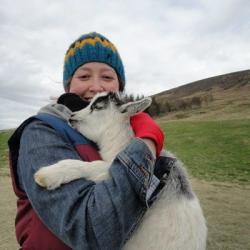Dansaðu fyrir mig at Tjarnarbíó
Currently in a limited return run in Reykjavík, the spare, searching, and ultimately joyful two-person show “Dansaðu fyrir mig,” (‘Dance for me’) starts from a basic premise—can an untrained, pot-bellied 49-year-old man realize his dream of dancing on stage?—and uses it as a platform to explore creation and collaboration, artistic vulnerability, aspiration and family-making.
Several years after partners Pétur Ármannsson, a director and theater-maker, and Brogan Davison, a choreographer and dancer, met and began working together on experimental and interdisciplinary performance pieces, Brogan received a Facebook message from Pétur’s father. This message, read on stage during the performance, asked Brogan for her help in making Ármann’s life-long dream of dancing in a contemporary dance piece a reality. She agreed, and with Pétur’s assistance, the three began collaborating on a piece which debuted in Akureyri in 2013 and has since gone on to showings around the country, including at last year’s Lókal international theater festival.
“Dansaðu fyrir mig” combines modern dance sequences, which Brogan and Ármann perform both together and separately, along with video interviews, improvised questions and answers, childhood memories, and musical performance. Although much of the piece has been set and rehearsed since its first showing, nightly performances vary somewhat, depending entirely on what Brogan and Ármann want to discuss between themselves, or to share with the audience. “How do you think that went?” Brogan asked Ármann after his opening dance at a performance on February 23. “Is that the best you’ve ever done it?” Ármann, out of breath and sitting splayed-legged on the floor after finishing the dance, which ended with him running triumphantly around the stage pumping his fist, nodded distractedly. “Alltaf.” Always.
The show is deeply personal and intimately staged. Ármann chit-chats with theater-goers as they enter the space, personally directing them to their seats—the first rows of which are set up right on the perimeters of the stage. Many of the dance and narrative sequences begin with he or Brogan taking a moment to just look at the audience, to make eye-contact and connect with the viewer. On occasion, this intimacy is reinforced just by virtue of watching the performers struggle. During the February 23 performance, Ármann stopped twice, breathless, in the middle of a dance sequence. The first time, he looked at Brogan, tired. Maybe a bit frustrated. The second, he pointed to a woman sitting in the front row. “That’s my cousin,” he laughed, going over to give her a quick squeeze. “We grew up together in the North Fjords.”
The dances are interspersed with short narratives and personal admissions. “I have a dream,” Brogan began one such piece. “I have a dream that I could be more comfortable in my body. I have a dream that my personality didn’t disappear when I stood before a group of strangers. I have a dream that I wouldn’t get dry mouth whenever I speak in front of people.”
Because, while the show is centered around Ármann’s great challenge—to dance—“Dansaðu fyrir mig” is also a space for Brogan to explore her own vulnerabilities and address her own obstacles as a performer. She relates memories from childhood (the day she was born there was a hurricane in her hometown of Brighton, England; her mother delivered her to midwives wearing hardhats and headlamps) as well as her own setbacks and struggles as a dancer (the time, at age ten, she failed at quitting ballet).
Late in the show, Brogan talks briefly about her struggles with depression, beginning to relate a litany of demeaning, infantilizing, or otherwise discouraging comments that people have made about her, as a person and a dancer, throughout her life. Ármann puts an end to this bit of brooding with an increasingly interruptive clarinet solo which he delivers, with great gusto, while bopping about the stage.
“When I want to feel good,” he tells her, upon finishing, “I dance like this.” Air kick. Side shimmy. Muppet-esque bop. Slowly, she too, begins to respond, begins, one supposes, to rediscover a little of the joy of purely enjoyable movement. “When I want to feel good,” she replies, “I dance like this.” Leap. Side step. Twist.
“Dansaðu fyrir mig” is performed in English (with a little Icelandic) and is showing at Tjarnarbíó on March 1st and 2nd. Purchase tickets here. The show will also be traveling to Canada as part of the 2014 Núna/Now Festival and later be staged in Frankfurt, Germany. Follow the performance schedule via the Facebook page or the website.
Buy subscriptions, t-shirts and more from our shop right here!
















